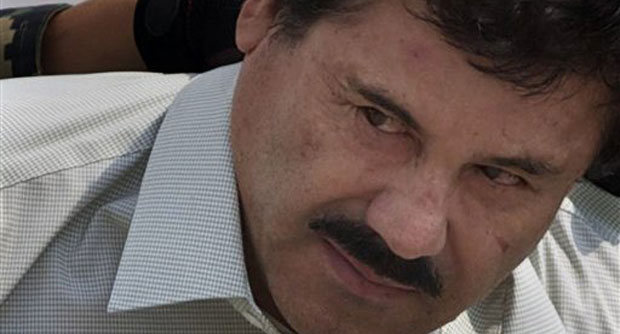
Joaquin “El Chapo” Guzman is escorted to a helicopter in handcuffs by Mexican navy marines at a navy hanger in Mexico City, Saturday, Feb. 22, 2014. AP
MEXICO CITY – Joaquin Guzman’s legend grew after the drug cartel kingpin broke out of a Mexican maximum-security prison in a laundry cart 13 years ago.
While on the run, the diminutive mafia boss, known as “El Chapo,” built a criminal empire that now stretches along Mexico’s Pacific coast and deals drugs to the United States, Europe and Asia.
A bit like Bigfoot, there were sightings of him across Mexico, often false, like reports that he had been killed in Guatemala last year.
Folk ballads known as “narcocorridos,” tributes to drug capos, sang his praises. He married an 18-year-old beauty queen, Emma Coronel, in 2007 and is believed to have 10 children with various women.
He is believed to have been brazen enough to walk into restaurants in his state of Sinaloa, ask diners to hand their cellphones to his bodyguards, eat calmly and pay everyone’s tabs before leaving.
But after eluding the authorities for years, narrowly escaping arrest as recently as 2012, the Sinaloa cartel boss was finally captured by Mexican marines on Saturday in the Pacific beach resort of Mazatlan.
The 56-year-old drug kingpin sported thick black hair and a matching mustache when authorities paraded in front of television cameras at a Mexico City navy base, flanked by two marines holding him by the neck.
The United States had offered a $5 million reward for information leading to the arrest of Guzman, who is accused of being behind much of the drug violence that has plagued Mexico for years.
His ability to sneak tons of cocaine, heroin and marijuana into the United States made him “Public Enemy Number One” in Chicago, joining American gangster Al Capone as the only criminal to ever get the moniker.
Guzman “easily surpassed the carnage and social destruction that was caused by Capone,” the Chicago Crime Commission said in February 2013.
He used to be on Forbes magazine’s list of billionaires until the US publication said in 2013 that it could not verify his wealth and that it believed he was increasingly spending on protection.
But “El Chapo” remained on the Forbes list of the world’s most powerful people, standing at number 67.
His arrest is a major success for the 14-month administration of President Enrique Pena Nieto, though Guzman’s top associate, Ismael “El Mayo” Zambada, remains on the run.
Violent reign
After he was captured in Guatemala in 1993, authorities paraded the short man, clean-shaven and wearing a thick winter jacket, with handcuffs in front of news cameras.
But he escaped in a Hollywood-worthy breakout from a Mexican maximum-security prison in 2001, hiding in a laundry basket.
He appeared chubby in pictures that surfaced later, but he became a fitness buff and exercise equipment was reportedly found in a house he was believed to have used in Baja California Sur state in 2012.
“He is fit,” said a US security official.
His cartel became entangled in brutal turf wars against the paramilitary-like Zetas cartel and other gangs for years.
More than 77,000 people have been killed in drug violence in Mexico in the past seven years.
The drug war began to escalate after former president Felipe Calderon sent the army and navy to rein in the cartels in 2006, a deployment that analysts say exacerbated the violence.
More than 10,000 were killed in Ciudad Juarez alone in violence attributed to battles between Sinaloa and Juarez cartel members for supremacy in the key drug corridor at the border with the US state of Texas.
Rise of Guzman
Guzman was born on April 4, 1957, in the Sinaloa village of Badiraguato.
He became involved in drug trafficking in the late 1980s when he worked for one of the earliest leaders of Mexico’s modern cartels, Miguel Angel Felix Gallardo, who led the Guadalajara gang until his capture in 1989.
Authorities say the Sinaloa drug cartel emerged in the 1990s after Felix Gallardo’s organization split following his arrest between Guzman’s faction and the Tijuana cartel.
A turf war ensued, with a gunfight in 1993 at the airport of Guadalajara that killed the western city’s archbishop, Cardinal Juan Jesus Posadas Ocampo, allegedly because he was mistaken for Guzman.
Guzman’s family has paid dearly for his life of crime. One of his brothers was killed in a Mexican jail in December 2004 and a son was killed in a Culiacan shopping center in May 2008.
His two ex-wives and several of his sons are also subject to US sanctions.
RELATED STORY
Mexico’s Sinaloa drug chief arrested